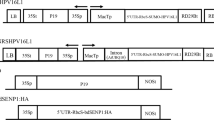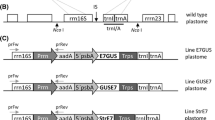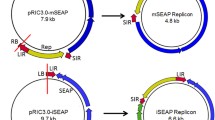Abstract
Certain types of human papillomaviruses (HPV) are causatively associated with cervical carcinoma, the second most common cancer in women worldwide. Due to limitations in the availability of currently used virus-like particle (VLP)-based vaccines against HPV to women of developing countries, where most cases of cervical cancer occur, the development of a cost-effective second-generation vaccine is a necessity. Capsomeres have recently been demonstrated to be highly immunogenic and to have a number of advantages as a potential cost-effective alternative to VLP-based HPV vaccines. We have expressed a mutated HPV-16 L1 (L1_2xCysM) gene that retained the ability to assemble L1 protein to capsomeres in tobacco chloroplasts. The recombinant protein yielded up to 1.5% of total soluble protein. The assembly of capsomeres was examined and verified by cesium chloride density gradient centrifugation and sucrose sedimentation analysis. An antigen capture enzyme-linked immunosorbent assay confirmed the formation of capsomeres by using a conformation-specific monoclonal antibody which recognized the conformational epitopes. Transplastomic tobacco plants exhibited normal growth and morphology, but all such lines showed male sterility in the T0, T1 and T2 generations. Taken together, these results indicate the possibility of producing a low-cost capsomere-based vaccine by plastids.




Similar content being viewed by others
References
Baker TS, Newcomb WW, Olson NH, Cowsert LM, Olson C, Brown JC (1991) Structures of bovine and human papillomaviruses. Biophys J 60:1445–1456
Biemelt S, Sonnewald U, Galmbacher P, Willmitzer L, Müller M (2003) Production of human papillomavirus type 16 viruslike particles in transgenic plants. J Virol 77:9211–9220
Bock R (2007) Plastid biotechnology: prospects for herbicide and insect resistance, metabolic engineering and molecular farming. Curr Opin Biotechnol 18:100–106
Chase CD (2007) Cytoplasmic male sterility: a window to the world of plant mitochondrial-nuclear interactions. Trends Genet 23:81–90
Chebolu S, Daniell H (2009) Chloroplast-derived vaccine antigens and biopharmaceuticals: expression, folding, assembly and functionality. Curr Top Microbiol Immunol 332:33–54
Chen XS, Garcea RL, Goldberg I, Casini G, Harrison SC (2000) Structure of small virus-like particles assembled from the L1 protein of human papillomavirus 16. Mol Cell 5:557–567
Chen XS, Casini G, Harrison SC, Garcea RL (2001) Papillomavirus capsid protein expression in Escherichia coli: purification and assembly of HPV11 and HPV16 L1. J Mol Biol 307:173–182
Daniell H, Streatfield SJ, Wycoff K (2001) Medical molecular farming: production of antibodies, biopharmaceuticals and edible vaccines in plants. Trends Plant Sci 6:219–226
Daniell H, Sing ND, Mason H, Streatfield SJ (2009) Plant-made vaccine antigens and biopharmaceuticals. Trends Plant Sci 14:669–679
Dell K, Koesters R, Linnebacher M, Klein C, Gissmann L (2006) Intranasal immunization with human papillomavirus type 16 capsomeres in the presence of non-toxic cholera toxin-based adjuvants elicits increased vaginal immunoglobulin levels. Vaccine 24:2238–2247
Fernandez-San Millan A, Ortigosa SM, Hervas-Stubbs S, Corral-Martınez P, Seguı-Simarro JM, Gaetan J, Coursaget P, Veramendi J (2008) Human papillomavirus L1 protein expressed in tobacco chloroplasts self-assembles into virus-like particles that are highly immunogenic. Plant Biotechnol J 6:427–441
Fischer R, Stoger E, Schillberg S, Christou P, Twyman RM (2004) Plant-based production of biopharmaceuticals. Curr Opin Plant Biol 7:152–158
Fligge C, Giroglou T, Streeck RE, Sapp M (2001) Induction of type-specific neutralizing antibodies by capsomeres of human papillomavirus type 33. Virology 283:353–357
Gamborg OL, Miller RA, Ojima K (1968) Nutrient requirements of suspension cultures of soybean root cells. Exp Cell Res 50:151–158
Hajdukiewicz PTJ, Allison LA, Maliga P (1997) The two plastid RNA polymerases encoded by the nuclear and plastid compartments transcribe distinct groups of genes in tobacco. EMBO J 16:4041–4048
Harper DM, Franco EL, Wheeler C, Ferris DG, Jenkins D, Schuind A, Zahaf T, Innis B, Naud P, De Carvalho NS, Roteli-Martins CM, Teixeira J, Blatter MM, Korn AP, Quint W, Dubin G, GlaxoSmithKline HPV Vaccine Study Group (2004) Efficacy of a bivalent L1 virus-like particle vaccine in prevention of infection with human papillomavirus types 16 and 18 in young women: a randomised controlled trial. Lancet 364:1757–1765
Ishii Y, Tanaka K, Kanda T (2003) Mutational analysis of human papillomavirus type 16 major capsid protein L1: the cysteines affecting the intermolecular bonding and structure of L1-capsids. Virology 308:128–136
Jain SM (2001) Tissue culture-derived variation in crop improvement. Euphytica 118:153–166
Koop HU, Herz S, Golds TJ, Nickelsen J (2007) The genetic transformation of plastids. Top Curr Genet 19:457–510
Koutsky LA, Ault KA, Wheeler CM, Brown DR, Barr E, Alvarez FB, Chiacchierini LM, Jansen KU (2002) A controlled trial of a human papillomavirus type 16 vaccine. N Engl J Med 347:1645–1651
Larkin PJ, Scowcroft WR (1981) Somaclonal variation: a novel source of variability from cell cultures for plant improvement. Theor Appl Genet 60:197–214
Lenzi P, Scotti N, Alagna F, Tornesello ML, Pompa A, Vitale A, De Stradis A, Monti L, Grillo S, Buonaguro FM, Maliga P, Cardi T (2008) Translational fusion of chloroplast-expressed human papillomavirus type 16 L1 capsid protein enhances antigen accumulation in transplastomic tobacco. Transgenic Res 17:1091–1102
Li M, Cripe TP, Estes PA, Lyon MK, Rose RC, Garcea RL (1997) Expression of the human papillomavirus type 11 L1 capsid protein in Escherichia coli: characterization of protein domains involved in DNA binding and capsid assembly. J Virol 71:2988–2995
Liu HL, Li WS, Lei T, Zheng J, Zhang Z, Yan XF, Wang ZZ, Wang YL, Si LS (2005) Expression of human papillomavirus type 16 L1 protein in transgenic tobacco plants. Acta Biochim Biophys Sin (Shanghai) 37:153–158
Lössl A, Eibl C, Harloff HJ, Jung C, Koop HU (2003) Polyester synthesis in transplastomic tobacco (Nicotiana tabacum L.): significant contents of polyhydroxybutyrate are associated with growth reduction. Plant Cell Rep 21:891–899
Lössl A, Bohmert K, Harloff H, Eibl C, Mühlbauer S, Koop HU (2005) Inducible trans-activation of plastid transgenes: expression of the R. eutrophaphb operon in transplastomic tobacco. Plant Cell Physiol 46:1462–1471
Ma JKC, Barros E, Bock R, Christou P, Dale PJ, Dix PJ, Fischer R, Irwin J, Mahoney R, Pezzotti M, Schillberg S, Sparrow P, Stoger E, Twyman RM (2005) Molecular farming for new drugs and vaccines. Current perspectives on the production of pharmaceuticals in transgenic plants. EMBO Rep 6:593–599
Maclean J, Koekemoer M, Olivier AJ, Stewart D, Hitzeroth II, Rademacher T, Fischer R, Williamson AL, Rybicki EP (2007) Optimization of human papillomavirus type 16 (HPV-16) L1 expression in plants: comparison of the suitability of different HPV-16 L1 gene variants and different cell-compartment localization. J Gen Virol 88:1460–1469
Maliga P (2002) Engineering the plastid genome of higher plants. Curr Opin Plant Biol 5:164–172
McCarthy MP, White WI, Palmer-Hill F, Koenig S, Suzich JA (1998) Quantitative disassembly and reassembly of human papillomavirus type 11 viruslike particles in vitro. J Virol 72:32–41
Müller M, Gissmann L (2007) A long way: history of the prophylactic papillomavirus vaccine. Dis Markers 23:331–336
Murashige T, Skoog F (1962) A revised medium for rapid growth and bioassays with tobacco tissue cultures. Physiol Plant 15:473–497
Murray SL, Thompson WF (1980) Rapid isolation of high molecular weight plant DNA. Nucleic Acids Res 8:4321–4325
Oey M, Lohse M, Kreikemeyer B, Bock R (2009) Exhaustion of the chloroplast protein synthesis capacity by massive expression of a highly stable protein antibiotic. Plant J 57:436–445
Öhlschläger P, Osen W, Dell K, Faath S, Garcea RL, Jochmus I, Müller M, Pawlita M, Schäfer K, Sehr P, Staib C, Sutter G, Gissmann L (2003) Human papillomavirus type 16 L1 capsomeres induce L1-specific cytotoxic T lymphocytes and tumor regression in C57BL/6 mice. J Virol 77:4635–4645
Parkin DM, Bray F (2006) Chapter 2: the burden of HPV-related cancers. Vaccine 24S3:S11–S25
Pelletier G, Budar F (2007) The molecular biology of cytoplasmically inherited male sterility and prospects for its engineering. Curr Opin Biotechnol 18:121–125
Rose RC, White WI, Li M, Suzich JA, Lane C, Garcea RL (1998) Human papillomavirus type 11 recombinant L1 capsomeres induce virus neutralizing antibodies. J Virol 72:6151–6154
Ruf S, Karcher D, Bock R (2007) Determining the transgene containment level provided by chloroplast transformation. Proc Natl Acad Sci USA 104:6998–7002
Ruiz ON, Daniell H (2005) Engineering cytoplasmic male sterility via the chloroplast genome by expression of ß-ketothiolase. Plant Physiol 138:1232–1246
Sambrook J, Fritsch EF, Maniatis T (1989) Molecular cloning: a laboratory manual, 2nd edn. Cold Spring Harbor Laboratory Press, Cold Spring Harbor
Sapp MC, Volpers C, Müller M, Streeck RE (1995) Organization of the major and minor capsid proteins in human papillomavirus type 33 virus-like particles. J Gen Virol 76:2407–2412
Sapp M, Fligge C, Petzak I, Harris JR, Streeck RE (1998) Papillomavirus assembly requires trimerization of the major capsid protein by disulfides between two highly conserved cysteines. J Virol 72:6186–6189
Schädlich L, Senger T, Kirschning CJ, Müller M, Gissmann L (2009a) Refining HPV 16 L1 purification from E. coli: reducing endotoxin contaminations and their impact on immunogenicity. Vaccine 27:1511–1522
Schädlich L, Senger T, Gerlach B, Mücke N, Klein C, Bravo IG, Müller M, Gissmann L (2009b) Analysis of modified human papillomavirus type 16 L1 capsomeres: the ability to assemble into larger particles correlates with higher immunogenicity. J Virol 83:7690–7705
Shinozaki K, Ohme M, Tanaka M, Wakasugi T, Hayashida N, Matsubayashi T, Zaita N, Chunwongse J, Obokata J, Yamaguchi-Shinozaki K, Ohto C, Torazawa K, Meng BY, Sugita M, Deno H, Kamogashira T, Yamada K, Kusuda J, Takaiwa F, Kato A, Tohdoh N, Shimada H, Sugiura M (1986) The complete nucleotide sequence of the tobacco chloroplast genome: its gene organization and expression. EMBO J 5:2043–2049
Sidorov VA, Kasten D, Pang SZ, Hajdukiewicz PTJ, Staub JM, Nehra N (1999) Stable chloroplast transformation in potato: use of green fluorescent protein as a plastid marker. Plant J 19:209–216
Smith JS, Lindsay L, Hoots B, Keys J, Franceschi S, Winer R, Clifford GM (2007) Human papillomavirus type distribution in invasive cervical cancer and high-grade cervical lesions: a meta-analysis update. Int J Cancer 121:621–632
Stanley M, Gissmann L, Nardelli-Haefliger D (2008) Immunobiology of human papillomavirus infection and vaccination—implications for second generation vaccines. Vaccine 26S:K62–K67
Studier FW, Rosenberg AH, Dunn J, Dubendorf JW (1990) Use of T7 RNA polymerase to direct expression of cloned genes. Meth Enzymol 185:60–89
Svab Z, Maliga P (1993) High-frequency plastid transformation in tobacco by selection for a chimeric aadA gene. Proc Natl Acad Sci USA 90:913–917
Svab Z, Hajdukiewicz P, Maliga P (1990) Stable transformation of plastids in higher plants. Proc Natl Acad Sci USA 87:8526–8530
Thönes N, Müller M (2007) Oral immunization with different assembly forms of the HPV 16 major capsid protein L1 induces neutralizing antibodies and cytotoxic T-lymphocytes. Virology 369:375–388
Thönes N, Herreiner A, Schädlich L, Piuko K, Müller M (2008) A direct comparison of human papillomavirus type 16 L1 particles reveals a lower immunogenicity of capsomeres than viruslike particles with respect to the induced antibody response. J Virol 82:5472–5485
Varsani A, Williamson AL, Rose RC, Jaffer M, Rybicki EP (2003) Expression of human papillomavirus type 16 major capsid protein in transgenic Nicotiana tabacum cv. Xanthi. Arch Virol 148:1771–1786
Villa LL, Costa RLR, Petta CA, Andrade RP, Paavonen J, Iversen OE, Olsson SE, Hoye J, Steinwall M, Riis-Johannessen G, Andersson-Ellstrom A, Elfgren K, Von Krogh G, Lehtinen M, Malm C, Tamms GM, Giacoletti K, Lupinacci L, Railkar R, Taddeo FJ, Bryan J, Esser MT, Sings HL, Saah AJ, Barr E (2006) High sustained efficacy of a prophylactic quadrivalent human papillomavirus types 6/11/16/18 L1 virus-like particle vaccine through 5 years of follow-up. Br J Cancer 95:1459–1466
Wakasugi T, Sugita M, Tsudzuki T, Sugiura M (1998) Updated gene map of tobacco chloroplast DNA. Plant Mol Biol Rep 16:231–241
Ye GN, Hajdukiewic PT, Broyles D, Rodriguez D, Xu CW, Nehra N, Staub JM (2001) Plastid-expressed 5-enolpyruvylshikimate-3-phosphate synthase genes provide high level glyphosate tolerance in tobacco. Plant J 25:261–270
Yuan H, Estes PA, Chen Y, Newsome J, Olcese VA, Garcea RL, Schlegel R (2001) Immunization with a pentameric L1 fusion protein protects against papillomavirus infection. J Virol 75:7848–7853
Yukawa M, Tsudzuki T, Sugiura M (2005) The 2005 version of the chloroplast DNA sequence from tobacco (Nicotiana tabacum). Plant Mol Biol Rep 23:359–365
Acknowledgments
A part of this work was conducted at Deutsches Krebsforschungszentrum, Germany. The study was partially financed by the GoF foundation. We want to express our gratitude for the support of Stefan Kirchner and Hans-Ulrich Koop at the Ludwig-Maximilians-University, Munich, Germany. Furthermore, we acknowledge the assistance of Elisabeth Geiger during the research work.
Author information
Authors and Affiliations
Corresponding author
Electronic supplementary material
Below is the link to the electronic supplementary material.
Rights and permissions
About this article
Cite this article
Waheed, M.T., Thönes, N., Müller, M. et al. Transplastomic expression of a modified human papillomavirus L1 protein leading to the assembly of capsomeres in tobacco: a step towards cost-effective second-generation vaccines. Transgenic Res 20, 271–282 (2011). https://doi.org/10.1007/s11248-010-9415-4
Received:
Accepted:
Published:
Issue Date:
DOI: https://doi.org/10.1007/s11248-010-9415-4




